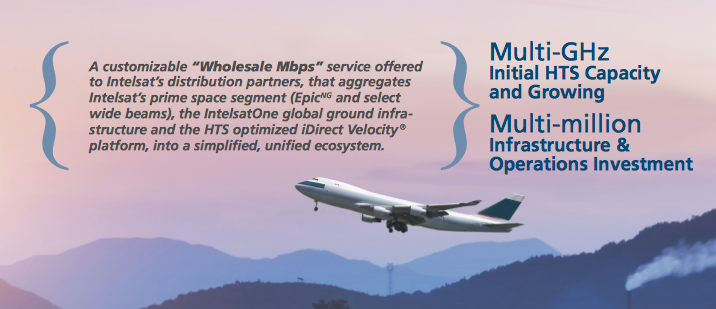
Introducing IntelsatOne® Flex
[SatNews] Intelsat S.A. (NYSE: I), provider of satellite services, has introduced IntelsatOne® Flex for distribution partners serving the commercial air transport market.
IntelsatOne Flex aggregates Intelsat’s global and Intelsat EpicNG® high throughput satellite (HTS) fleet and the IntelsatOne terrestrial network into a simplified ecosystem that enables Intelsat’s distribution partners to easily, and cost efficiently, scale their service delivery capability to meet emerging in-flight demands.
An enterprise grade, customizable “Wholesale Mbps”, managed mobility service; IntelsatOne Flex allows Intelsat’s distribution partners and their aeronautical customers to access bandwidth when and where it is needed the most without the complexity of managing multiple beams and satellites. In addition, it provides tiered Committed Information Rate (CIR) plans that mean Intelsat distribution partners can offer unique and tailored services to the air transport sector.
Christopher Baugh, President, NSR stated, “With high throughput satellite technology forthcoming, the inflight-communications and entertainment market is poised to take off. We anticipate that the number of global aeronautical satcom units will increase from 47,500 units in 2014 to 95,500 units by the end of 2024. In order to capture this market growth, aeronautical service providers and airlines will benefit greatly from having this new technology in their networks.”
IntelsatOne Flex service will enable Intelsat aero distribution partners to:
- Maintain Control over their network by allowing them to continue to manage the customization, contention and prioritization of individual airborne terminals without the overhead of multiple network builds and inefficient use of bandwidth.
- Streamline the management of capacity for geographic expansion and surge, providing flexibility across multiple satellite beams and resulting in a more predictable cost structure directly matched to revenue generating activities.
- Leverage wide beams for broadcast applications to the plane and high throughput spot beams for high throughput data.
- Rapidly and cost effectively expand while retaining control over service differentiation, brand and visibility of end-user terminals.
- Customize the Quality of Service for “wholesale Mbps” procured on a region-by-region basis, bound by a Service Level Agreement (SLA) and underpinned by guaranteed CIRs.
- Minimize operational costs associated with network infrastructure, allowing service providers to focus on product differentiation, value added services and revenue growth.
- Lower Total Cost of Ownership through reduction in capital expenditure and elimination of unnecessary bandwidth overhead.
James Collett, Head of Mobility and Energy Services, Intelsat, said, “Inflight entertainment is no longer a nice-to-have element for airlines today. Passengers require the same level of connectivity that they would receive at home or in the office. This leaves many airlines and their distribution partners needing to rapidly invest in new technology to meet growing bandwidth demands, satisfy the needs of passengers and capture revenue growth. However, integrating new technology can be a complex process and choosing the wrong network, a costly mistake.
With IntelsatOne Flex, aeronautical distribution partners have a new option that provides a flexible operational environment that easily scales to meet growing broadband requirements, optimizes bandwidth allocations and aligns costs with revenue demands. Importantly, to take advantage of the power, accessibility and efficiency of Intelsat EpicNG, aeronautical distribution partners can easily integrate high throughput technology into existing networks with minimal capital expenditure and provide a platform that will support their technology requirements well into the future.”
With Intelsat’s global Ku-band satellite fleet and Intelsat EpicNG high throughput satellite platform, distribution partners using IntelsatOne Flex will benefit from a global network and coverage. Intelsat’s wide beams will enable the accommodation of broadcast applications and service to the most remote regions, while fully integrated spot beams will provide layers of high throughput capacity across the highest traffic routes.
IntelsatOne Flex uses iDirect Velocity®, a ground infrastructure platform designed for large-scale global HTS networks, which has been fully optimized for Intelsat EpicNG to provide scalability, performance and higher throughput. Leveraging iDirect Velocity, IntelsatOne Flex incorporates features that have been optimized to the Intelsat EpicNG environment including next-generation remote and hub processing capabilities that enable significantly higher throughput rates and global bandwidth management ensuring seamless connectivity across multiple spot-beams, and very fast beam switching features. IntelsatOne Flex is fully integrated with Velocity’s companion network management system, Pulse®, enabling Intelsat distribution partners to develop differentiated service offerings, create customized applications and system integration through open APIs and provide visibility for real-time monitoring, tracking and adjustment of vessel service levels.
For more information, please visit Intelsat at the Global Connected Aircraft Summit 2015 which is taking place at the Westfield Marriott Washington Dulles located in Chantilly, Virginia between June 8-10.
James Collett, Intelsat’s Head of Mobility and Energy Services participated on a panel on June 9, entitled “Ku-band vs. Ka-band: Pros and Cons of Each Band” at 10:45 am EDT. In addition, Vinit Duggal, Intelsat’s Director and Chief Security Officer, will be featured on a panel on June 10, where he will address “Cyber Security: How Can a Connected Aircraft Manage this Threat?” at 2:20 pm.